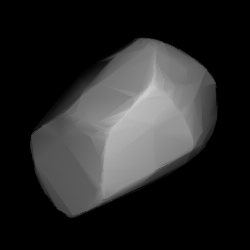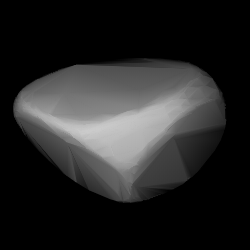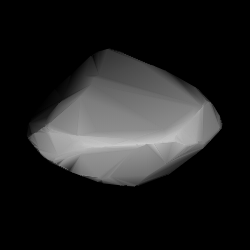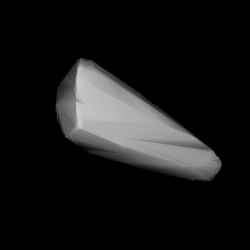Related Research Articles

364 Isara is a stony Florian asteroid from the inner regions of the asteroid belt, approximately 27 kilometers in diameter. It was discovered on 19 March 1893, by French astronomer Auguste Charlois at the Nice Observatory in southeast France. The asteroid was named after the Isère River in France.

744 Aguntina, provisional designation 1913 QW, is a rare-type carbonaceous asteroid from the outer region of the asteroid belt, about 60 kilometers in diameter. It was discovered by Austrian astronomer Joseph Rheden at Vienna Observatory, Austria, on 26 February 1913.

958 Asplinda is a resonant Hilda asteroid, approximately 47 kilometers in diameter, located in the outermost region of the asteroid belt. It was discovered on 28 September 1921, by astronomer Karl Reinmuth at the Heidelberg Observatory in southwest Germany. The assumed C-type asteroid has a rotation period of 16.5 hours and is likely elongated in shape. It was named after Swedish astronomer Bror Asplind (1890–1954).
2531 Cambridge, provisional designation 1980 LD, is a stony Eoan asteroid from the outer regions of the asteroid belt, approximately 20 kilometers in diameter. It was discovered on 11 June 1980, by American astronomer Edward Bowell at Lowell's Anderson Mesa Station in Arizona, United States. The asteroid was named for the "centers of learning in England and in Massachusetts".

1275 Cimbria is a Eunomia asteroid from the central regions of the asteroid belt, approximately 27 kilometers in diameter. It was discovered on 30 November 1932, by astronomer Karl Reinmuth at the Heidelberg-Königstuhl State Observatory in southern Germany. The asteroid was named after the Cimbri, an ancient Germanic tribe.
1199 Geldonia is an Eoan asteroid from the outer regions of the asteroid belt, approximately 32 kilometers in diameter. It was discovered on 14 September 1931, by Belgian astronomer Eugène Delporte at the Royal Observatory of Belgium in Uccle. The asteroid was named after the Belgian town of Jodoigne.

2483 Guinevere is a dark and elongated Hilda asteroid from the outermost regions of the asteroid belt, approximately 43 kilometers in diameter. The asteroid was discovered on 17 August 1928, by German astronomer Max Wolf at Heidelberg Observatory in southwest Germany and given the provisional designation 1928 QB. In the 1980s, it was named after King Arthur's wife Guinevere.
1308 Halleria, provisional designation 1931 EB, is a carbonaceous Charis asteroid from the outer regions of the asteroid belt, approximately 43 kilometers in diameter. It was discovered on 12 March 1931, by German astronomer Karl Reinmuth at the Heidelberg-Königstuhl State Observatory. The asteroid was named after Albrecht von Haller a Swiss physician, botanist and poet.
1384 Kniertje, provisional designation 1934 RX, is a dark Adeonian asteroid from the central regions of the asteroid belt, approximately 26 kilometers in diameter. It was discovered on 9 September 1934, by Dutch astronomer Hendrik van Gent at the Union Observatory in Johannesburg, South Africa. The asteroid was named after a character in the Dutch play Op Hoop van Zegen by Herman Heijermans.

1256 Normannia is a dark Hilda asteroid and slow rotator from the outermost regions of the asteroid belt, approximately 69 kilometers in diameter. It was discovered on 8 August 1932, by astronomer Karl Reinmuth at the Heidelberg-Königstuhl State Observatory in Germany. The asteroid was likely named after the Normans who gave their name to the region of Normandy in France.

1512 Oulu, provisional designation 1939 FE, is a dark Hildian asteroid, slow rotator and possibly the largest known tumbler orbiting in the outermost region of the asteroid belt. With a diameter of approximately 80 kilometers, it belongs to the fifty largest asteroids in the outer main-belt. The body was discovered on 18 March 1939, by Finnish astronomer Heikki Alikoski at Turku Observatory in Southwest Finland and named for the Finnish town Oulu.
1269 Rollandia, provisional designation 1930 SH, is a dark Hildian asteroid from the outermost region of the asteroid belt, approximately 105 kilometers (65 mi) in diameter. It was discovered on 20 September 1930, by Soviet astronomer Grigory Neujmin at the Simeiz Observatory on the Crimean peninsula. The asteroid was named after French writer Romain Rolland. The D-type asteroid has a rotation period of 17.4 hours. It was one of the last 100-kilometer sized asteroids discovered in the main belt.
2959 Scholl, provisional designation 1983 RE2, is a carbonaceous Hildian asteroid from the outer regions of the asteroid belt, approximately 34 kilometers in diameter. It was discovered on 4 September 1983 by English–American astronomer Edward Bowell of the Lowell Observatory at Anderson Mesa Station near Flagstaff, Arizona. The asteroid was named after German astronomer Hans Scholl.
1911 Schubart, provisional designation 1973 UD, is a dark Hildian asteroid and parent body of the Schubart family, located in the outermost region of the asteroid belt, approximately 70 kilometers in diameter. It was discovered on 25 October 1973, by Swiss astronomer Paul Wild at Zimmerwald Observatory, near Bern, Switzerland. The asteroid was named after German astronomer Joachim Schubart.

1801 Titicaca (prov. designation: 1952 SP1) is a stony Eos asteroid from the asteroid belt, approximately 22 kilometers in diameter. It was discovered on 23 September 1952, by Argentine astronomer Miguel Itzigsohn at La Plata Observatory in the capital of the province of Buenos Aires. It was named after Lake Titicaca in South America.

1186 Turnera, provisional designation 1929 PL, is a stony Eoan asteroid from the outer regions of the asteroid belt, approximately 36 kilometers in diameter. It was discovered on 1 August 1929, by South African astronomer Cyril Jackson at the Union Observatory in Johannesburg. The asteroid was later named after British astronomer Herbert Hall Turner.

4230 van den Bergh (prov. designation: 1973 ST1) is a highly elongated Hildian asteroid and member of the Schubart family from the outer regions of the asteroid belt. It was discovered on 19 September 1973, by Dutch astronomer couple Ingrid and Cornelis van Houten at Leiden Observatory, on photographic plates taken by Dutch–American astronomer Tom Gehrels at the Palomar Observatory, California. The assumed carbonaceous C-type asteroid has a very long rotation period of 88 hours and measures approximately 37 kilometers (23 miles) in diameter. It was named for Dutch–Canadian astronomer Sidney Van den Bergh.
1340 Yvette, provisional designation 1934 YA, is a carbonaceous Themistian asteroid from the outer regions of the asteroid belt, approximately 29 kilometers in diameter. It was discovered on 27 December 1934, by astronomer Louis Boyer at the Algiers Observatory, who named it after his niece, Yvette.

1336 Zeelandia, provisional designation 1934 RW, is a stony Koronian asteroid from the outer regions of the asteroid belt, approximately 21 kilometers in diameter. It was discovered on 9 September 1934, by Dutch astronomer Hendrik van Gent at the Union Observatory in Johannesburg, South Africa. The asteroid was named for the Dutch province of Zeeland.
1734 Zhongolovich, provisional designation 1928 TJ, is a carbonaceous Dorian asteroid from the central region of the asteroid belt, approximately 28 kilometers in diameter.
References
- 1 2 3 4 5 6 7 8 9 10 11 "JPL Small-Body Database Browser: 1212 Francette (1931 XC)" (2017-11-27 last obs.). Jet Propulsion Laboratory . Retrieved 5 January 2018.
- 1 2 3 Schmadel, Lutz D. (2007). "(1212) Francette". Dictionary of Minor Planet Names. Springer Berlin Heidelberg. p. 101. doi:10.1007/978-3-540-29925-7_1213. ISBN 978-3-540-00238-3.
- 1 2 3 4 5 6 "LCDB Data for (1212) Francette". Asteroid Lightcurve Database (LCDB). Retrieved 5 January 2018.
- 1 2 "Asteroid 1212 Francette – Nesvorny HCM Asteroid Families V3.0". Small Bodies Data Ferret. Archived from the original on 4 October 2020. Retrieved 26 October 2019.
- 1 2 3 Grav, T.; Mainzer, A. K.; Bauer, J.; Masiero, J.; Spahr, T.; McMillan, R. S.; et al. (January 2012). "WISE/NEOWISE Observations of the Hilda Population: Preliminary Results". The Astrophysical Journal. 744 (2): 15. arXiv: 1110.0283 . Bibcode:2012ApJ...744..197G. doi:10.1088/0004-637X/744/2/197. S2CID 44000310 . Retrieved 5 January 2018.
- 1 2 3 4 5 Tedesco, E. F.; Noah, P. V.; Noah, M.; Price, S. D. (October 2004). "IRAS Minor Planet Survey V6.0". NASA Planetary Data System. 12: IRAS-A-FPA-3-RDR-IMPS-V6.0. Bibcode:2004PDSS...12.....T . Retrieved 22 October 2019.
- 1 2 3 4 Usui, Fumihiko; Kuroda, Daisuke; Müller, Thomas G.; Hasegawa, Sunao; Ishiguro, Masateru; Ootsubo, Takafumi; et al. (October 2011). "Asteroid Catalog Using Akari: AKARI/IRC Mid-Infrared Asteroid Survey". Publications of the Astronomical Society of Japan. 63 (5): 1117–1138. Bibcode:2011PASJ...63.1117U. doi: 10.1093/pasj/63.5.1117 . (online, AcuA catalog p. 153)
- 1 2 Taylor, R. C.; Gehrels, T.; Capen, R. C. (September 1976). "Minor planets and related objects. XXI – Photometry of eight asteroids". Astronomical Journal. 81: 778–786.NASA–supportedresearch. Bibcode:1976AJ.....81..778T. doi:10.1086/111953 . Retrieved 5 January 2018.
- 1 2 Warner, Brian D.; Stephens, Robert D.; Coley, Daniel A. (January 2017). "Lightcurve Analysis of Hilda Asteroids at the Center for Solar System Studies: 2016 June-September". The Minor Planet Bulletin. 44 (1): 36–41. Bibcode:2017MPBu...44...36W. ISSN 1052-8091. PMC 7243970 . PMID 32455390.
- 1 2 3 4 Mainzer, A.; Grav, T.; Masiero, J.; Hand, E.; Bauer, J.; Tholen, D.; et al. (November 2011). "NEOWISE Studies of Spectrophotometrically Classified Asteroids: Preliminary Results". The Astrophysical Journal. 741 (2): 25. arXiv: 1109.6407 . Bibcode:2011ApJ...741...90M. doi:10.1088/0004-637X/741/2/90. S2CID 35447010.
- ↑ Veres, Peter; Jedicke, Robert; Fitzsimmons, Alan; Denneau, Larry; Granvik, Mikael; Bolin, Bryce; et al. (November 2015). "Absolute magnitudes and slope parameters for 250,000 asteroids observed by Pan-STARRS PS1 - Preliminary results". Icarus. 261: 34–47. arXiv: 1506.00762 . Bibcode:2015Icar..261...34V. doi:10.1016/j.icarus.2015.08.007. S2CID 53493339 . Retrieved 5 January 2018.
- 1 2 "1212 Francette (1931 XC)". Minor Planet Center. Retrieved 5 January 2018.
- ↑ Nesvorný, D.; Broz, M.; Carruba, V. (December 2014). "Identification and Dynamical Properties of Asteroid Families". Asteroids IV. pp. 297–321. arXiv: 1502.01628 . Bibcode:2015aste.book..297N. doi:10.2458/azu_uapress_9780816532131-ch016. ISBN 9780816532131. S2CID 119280014.